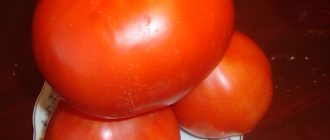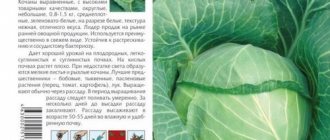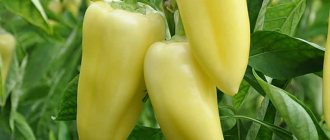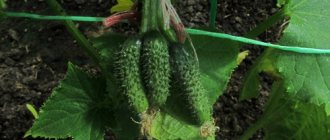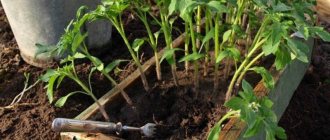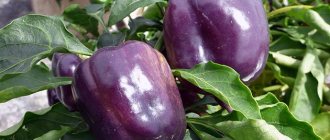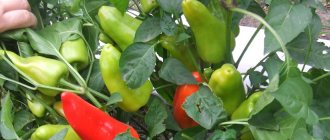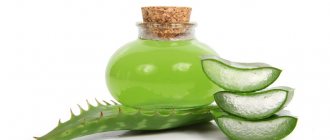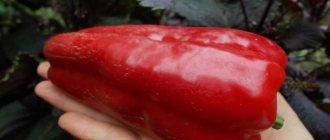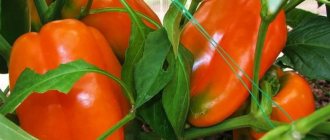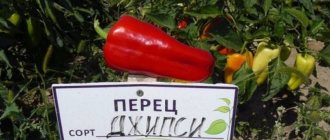Description and characteristics of the variety
Sweet pepper Belladonna F1 was included in the State Register of the Russian Federation in 2007. The vegetable is recommended to be grown in open ground and film greenhouses (a greenhouse is necessary in the north and in regions with unstable weather).
The hybrid is immune to tobacco mosaic.
The variety is early ripening: the first fruits appear 90 days after germination. The bush is of medium height, in open ground reaches 50–60 cm, in a greenhouse - up to 80 cm.
The fruits are cube-shaped, 11 cm long and up to 10 cm wide. Peppers with thick walls that contain a lot of juice and pulp are 6–7 cm long. There are 3–4 seed chambers inside. The average weight of each fruit is 120–140 g, but there are specimens up to 200 g. The color is deep yellow.
The fruits are used fresh, for preservation and in cooking.
Description of sweet pepper Belladonna F1, reviews, photos
An early-ripening, thick-walled hybrid of sweet peppers for open ground and film shelters.
The period from germination to the beginning of ripening is about 90 days. The bush is closed, 60-80 cm high. The leaves are small to medium in size, green, slightly wrinkled.
Belladonna sweet pepper was included in the State Register of the Russian Federation in 2007 for cultivation in open ground and under film covers on private farms.
Fruit characteristics
The fruits are drooping, cube-shaped, glossy, 3- and 4-chambered, greenish-white at the stage of technical ripeness, light yellow at the biological stage, weighing 120-140 grams (according to reviews up to 200 g), excellent taste without bitterness. Wall thickness 6-7 mm. This pepper is good for fresh consumption.
Productivity in open ground is 4.2-4.5 kg/sq.m.
Advantages of the hybrid : high resistance to tobacco mosaic virus, excellent commercial quality of the fruit.
Landing
Seeds are sown 60–70 days before transplanting the bushes to the garden bed. The seed material of hybrids is not processed before sowing. The soil is prepared from peat, garden soil and sand, adding a little mineral fertilizer and wood ash. If the substrate is created independently and not purchased in a store, it is spilled with a hot solution of potassium permanganate.
Before germination, plantings are kept under film at +26–28 degrees. Then the temperature is reduced and good lighting is provided.
They dive after 2–3 true leaves appear, preferably in peat pots.
After picking, plants temporarily stop growing due to stress. Then they are sprayed with a solution of the Epin stimulant.
They are transplanted into a garden bed according to a 50 by 70 cm pattern.
Pepper varieties with different ripening periods
Cultivars with different ripening periods will allow you to enjoy the long-awaited harvest all summer long - early ripening ones will be ready in the greenhouse by mid-June, later varieties are harvested in July - early August. Highly productive peppers with long fruiting will delight you right up to frost. Moreover, in protected beds this is quite possible - maintaining a comfortable temperature for the vegetable, a balanced diet, and regular watering allows you to obtain a guaranteed pepper harvest every year.
Early ripening pepper for the greenhouse
Ultra-early varieties and hybrids can be picked 80–90 years after sowing. Early ripening peppers must be eaten in the protected beds of experienced gardeners - these cultivars will provide the owner of the plot with useful fruits already at the beginning of the gardening season. The first wave of fruiting of such peppers is most often used for fresh consumption and as side dishes.
Belladonna F1
A classic pepper with soft green cube-shaped fruits, Belladonna F1 is well suited for salads and stuffed side dishes. The persistent peppery aroma is especially appreciated in this hybrid. The seed chambers are small, the pulp is quite thick - up to 7 mm. Thin-skinned, yet dense, sweetish Belladonna peppers (150 g each) are ideal for slicing and serving. The cultivar is often grown on an industrial scale - on average, the yield in protected beds reaches 5 kg per 1 sq. m, with proper care - up to 9–12 kg/m2, transportability and keeping quality of the crop are valued. The ultra-early hybrid (ripening 92 days after sowing) grows well in any conditions - in protected beds and in open ground.
The Dutch hybrid Belladonna F1 has medium-sized, stocky bushes (up to 0.7 m) - they are wind-resistant, do not fall over, and produce ovaries up to the top tier of foliage.
But I liked Belladonna the most - I got the most yield, and it’s just right for stuffing, not cloyingly sweet, just right, the shape is convenient. I really like the taste of beladonna.
Emma
https://forum.prihoz.ru/viewtopic.php?t=4986&start=330
Video: pepper variety Belladonna F1
Snowball F1
One of the first to ripen in greenhouse beds (95–106 days) Snowball F1 with prismatic glossy scarlet fruits. The harvest is formed on powerful standard bushes - the fruits are drooping, densely located along the stem. Their flesh is dense, not thick - about 5 mm, the skin is easily eaten - the pepper is ideal for stuffing and freezing for future use. A pleasant peppery aroma and sourness are the highlight of the hybrid. Red-sided Snowballs weigh up to 87 g, and the yield per bush is up to 4.5–6 kg, on average per 1 square meter. m reaches 11–14 kg. The peculiarity of the cultivar is resistance to low temperatures and low susceptibility to the tobacco mosaic virus.
I liked the Snezhok and Bogatyr peppers - juicy, crispy, with a lot of fiber. I don’t bury the peppers - they don’t like them. I plant them in the hole at the level at which they grew in the seedling container. The soil under the peppers should always be well moistened. I water it with hot water. For my peppers and cucumbers, water is heated in a black barrel.
night-73
https://www.nn.ru/community/dom/dacha/?do=read&thread=2504287&topic_id=56951682
Pepper Snowball F1 is distinguished by its juiciness and pleasant taste, the fruits are elongated, with weakly expressed longitudinal ribbing
Cardinal F1
A Dutch hybrid with ultra-early ripening (it begins to bear fruit on the 86th day) Cardinal F1 belongs to the red-fruited, thick-fleshed cultivars. Although, when fully ripe, its fruits become blue-black. Taste and yield are a feature of the hybrid. The thick-walled, sweetish pulp (wall thickness 8–11 mm) with a pronounced peppery smell is especially valued among gourmets, while the yield from one Cardinal bush reaches 6–7 kg. With the right agricultural technology, the hybrid is capable of yielding up to 14–16 kg per 1 sq. m. The fruits are cube-shaped, weighing from 150 to 380 g. The overseas cultivar is loved by domestic gardeners for its unpretentiousness, heat resistance and high immunity to many diseases. Cardinal fruits are always useful in home cooking: they are frozen and dried, pickled in spicy sauce.
The variety really turned out to be early ripening, with very beautiful large fruits. Peppers are tasty, juicy, and very good in salads. But they behaved poorly during heat treatment. If the purple pepper is initially boiled or fried, then its magnificent color disappears, it becomes pale, incomprehensible. It’s still suitable for preparing vegetable stews, but I didn’t dare use it in canned food.
Verbascum
https://spasibovsem.ru/responses/shikarnyj-perets-s-neustojchivoj-okraskoj.html
Hybrid Cardinal F1 is not demanding of care - it bears fruit equally well in a greenhouse and in outdoor beds
Mid-season greenhouse pepper
Mid-ripening varieties bear fruit 110–120 days from the date of planting, and late cultivars begin to bear fruit no earlier than 130–140 days from the date of sowing. Often, mid-season and late-season peppers are best stored and are more resistant to diseases and pests.
Cockatoo F1
Mid-season hybrid (ripening at 120–130 days) Kakadu F1 with excellent trunk-shaped fruits is intended for forcing in a greenhouse. Peppercorns with moderately thick pulp walls (5–6 mm) are narrow, have an elongated shape, and weigh 200 g. When biological ripeness occurs, they turn red. Most likely, the harvest will be suitable for stuffing or canning - Kakadu fruits have a persistent aroma and a pleasant taste with sourness. The cultivar forms many ovaries on powerful spreading bushes. The peculiarity of the hybrid is that Kakadu bears fruit without much hassle and in open ground. According to reviews, the return does not differ from that which occurs during greenhouse forcing - 8–10 kg/m2.
Mature Kakadu pepper bushes always bring joy. They are unpretentious and do not require much care. Quite tall (about a meter in a greenhouse) and moderately spreading, strewn with long pointed peppers. These peppers are quite thick-walled, juicy, and store well. We eat them both ripe (bright red) and at technical ripeness. Great for making or freezing. Perhaps one of the few varieties that has been proven over the years and consistently produces high yields until late autumn.
Ina9l
https://otzovik.com/review_5263590.html
Kakadu pepper does not suffer from tobacco mosaic and cladosporiosis, and is resistant to temperature changes
Star of the East chocolate F1
The dark-fruited hybrid Star of the East chocolate F1, recommended by the State Register for growing under film covers, will be a discovery for lovers of unusually colored peppers. The harvest can be eaten fresh, stuffed, pickled and frozen. When fully ripe, the chocolate Star will “shine” with a dark brown color - the glossy shade of the cube-shaped fruits, the pleasant-tasting skin, and the juicy pulp will make you fall in love with the hybrid forever. Among all the varieties of this pepper (they have red and orange fruits), the chocolate one may not be the most productive - 10 kg per 1 sq. m, although for many this is a completely encouraging indicator, it is also quite whimsical - it prefers exclusively greenhouse forcing. But in terms of large-fruitedness, it is the leader in the “family of eastern stars”, weighing 220–360 g, and the thick walls of the fruits of this cultivar can only be envied – up to 8–9 mm.
Pepper Star of the East chocolate F1, subject to crop rotation, is quite resistant to bacterial diseases
I have a chocolate Eastern Star that is definitely thick-walled and large, good for stuffing. But the number of fruits is 5-6 pieces on a bush, this is not enough.
allussik
https://www.forumhouse.ru/threads/161673/page-152
Video: Eastern Star chocolate pepper F1
Pilgrim F1
Hybrid Pilgrim F1 ripens 120 days after sowing and is famous for its fleshy, fragrant fruits. Weighty burgundy-scarlet peppercorns in the shape of a cube with a concave tip weigh about 140 g, the wall thickness is almost 8 mm. Pilgrim's harvest is good both in fresh snacks and in preparations. The cultivar has a good yield indicator - the standard is 10–14 kg per 1 sq. m. Pilgrim F1’s low susceptibility to tobacco mosaic virus, fusarium and powdery mildew is another bonus for gardeners who choose this pepper. The plant is tall; if the harvest is abundant, it is recommended to tie the stems to a support.
The cuboid, slightly ribbed fruits of Pilgrim F1 are stored well in a cool room
